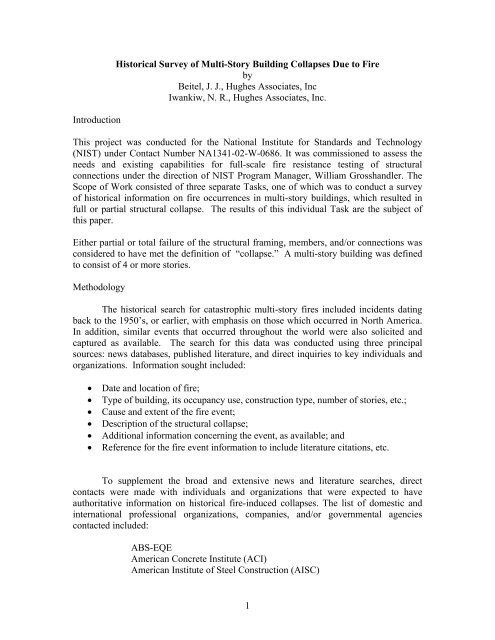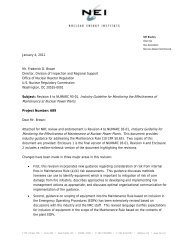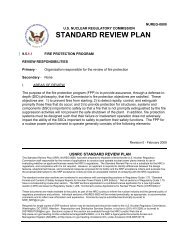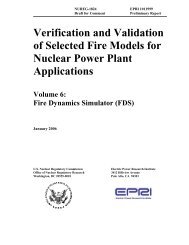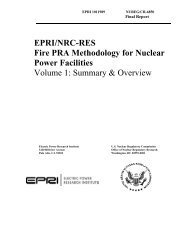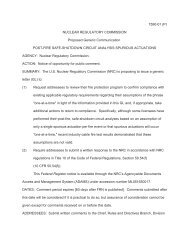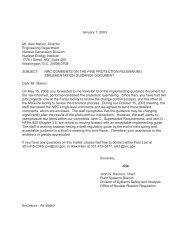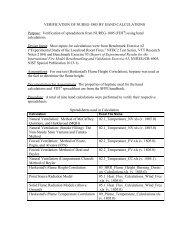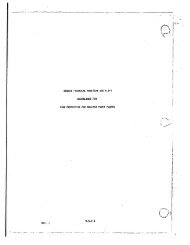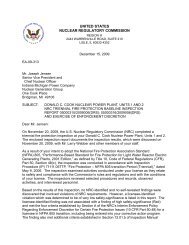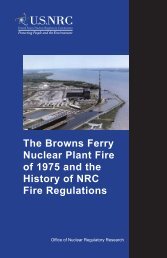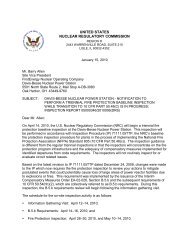Historical Survey of Multi-Story Building Collapses Due to Fire
Historical Survey of Multi-Story Building Collapses Due to Fire
Historical Survey of Multi-Story Building Collapses Due to Fire
You also want an ePaper? Increase the reach of your titles
YUMPU automatically turns print PDFs into web optimized ePapers that Google loves.
Introduction<br />
<strong>His<strong>to</strong>rical</strong> <strong>Survey</strong> <strong>of</strong> <strong>Multi</strong>-<strong>S<strong>to</strong>ry</strong> <strong>Building</strong> <strong>Collapses</strong> <strong>Due</strong> <strong>to</strong> <strong>Fire</strong><br />
by<br />
Beitel, J. J., Hughes Associates, Inc<br />
Iwankiw, N. R., Hughes Associates, Inc.<br />
This project was conducted for the National Institute for Standards and Technology<br />
(NIST) under Contact Number NA1341-02-W-0686. It was commissioned <strong>to</strong> assess the<br />
needs and existing capabilities for full-scale fire resistance testing <strong>of</strong> structural<br />
connections under the direction <strong>of</strong> NIST Program Manager, William Grosshandler. The<br />
Scope <strong>of</strong> Work consisted <strong>of</strong> three separate Tasks, one <strong>of</strong> which was <strong>to</strong> conduct a survey<br />
<strong>of</strong> his<strong>to</strong>rical information on fire occurrences in multi-s<strong>to</strong>ry buildings, which resulted in<br />
full or partial structural collapse. The results <strong>of</strong> this individual Task are the subject <strong>of</strong><br />
this paper.<br />
Either partial or <strong>to</strong>tal failure <strong>of</strong> the structural framing, members, and/or connections was<br />
considered <strong>to</strong> have met the definition <strong>of</strong> “collapse.” A multi-s<strong>to</strong>ry building was defined<br />
<strong>to</strong> consist <strong>of</strong> 4 or more s<strong>to</strong>ries.<br />
Methodology<br />
The his<strong>to</strong>rical search for catastrophic multi-s<strong>to</strong>ry fires included incidents dating<br />
back <strong>to</strong> the 1950’s, or earlier, with emphasis on those which occurred in North America.<br />
In addition, similar events that occurred throughout the world were also solicited and<br />
captured as available. The search for this data was conducted using three principal<br />
sources: news databases, published literature, and direct inquiries <strong>to</strong> key individuals and<br />
organizations. Information sought included:<br />
• Date and location <strong>of</strong> fire;<br />
• Type <strong>of</strong> building, its occupancy use, construction type, number <strong>of</strong> s<strong>to</strong>ries, etc.;<br />
• Cause and extent <strong>of</strong> the fire event;<br />
• Description <strong>of</strong> the structural collapse;<br />
• Additional information concerning the event, as available; and<br />
• Reference for the fire event information <strong>to</strong> include literature citations, etc.<br />
To supplement the broad and extensive news and literature searches, direct<br />
contacts were made with individuals and organizations that were expected <strong>to</strong> have<br />
authoritative information on his<strong>to</strong>rical fire-induced collapses. The list <strong>of</strong> domestic and<br />
international pr<strong>of</strong>essional organizations, companies, and/or governmental agencies<br />
contacted included:<br />
ABS-EQE<br />
American Concrete Institute (ACI)<br />
American Institute <strong>of</strong> Steel Construction (AISC)<br />
1
American Iron and Steel Institute (AISI)<br />
American Society <strong>of</strong> Civil Engineers (ASCE)<br />
Arbed Steel<br />
British Constructional Steel Association (BCSA)<br />
Canadian Institute <strong>of</strong> Steel Construction (CISC)<br />
Construction Technology Labora<strong>to</strong>ry (CTL)<br />
Corus-British Steel<br />
CTICM, France<br />
Disaster Prevention Institute, Kyo<strong>to</strong> University, Japan<br />
Fac<strong>to</strong>ry Mutual Research Corporation (FMRC)<br />
Institute for Business and Home Safety<br />
International Association For <strong>Fire</strong> Safety Science (IAFSS)<br />
Isolatek International<br />
Mexican Institute <strong>of</strong> Steel Construction (IMCA)<br />
National <strong>Fire</strong> Protection Association (NFPA)<br />
National Institute for <strong>Fire</strong> and Research (Japan)<br />
National Research Council <strong>of</strong> Canada (NRCC)<br />
Nucor-Yama<strong>to</strong> Steel Corp.<br />
Society for <strong>Fire</strong> Protection Engineers (SFPE)<br />
Vic<strong>to</strong>ria University <strong>of</strong> Technology, Australia<br />
In addition, a survey request for information was sent <strong>to</strong> several prominent engineers and<br />
consulting firms.<br />
In order <strong>to</strong> have been included in this incident tabulation, fire needed <strong>to</strong> have been judged<br />
the proximate cause for the building collapse (partial or <strong>to</strong>tal). Hence, any collapses due<br />
primarily <strong>to</strong> explosions, impacts, earthquakes, wind, and other construction or design<br />
fac<strong>to</strong>rs were beyond the scope <strong>of</strong> this survey, even if fires had developed during the<br />
course <strong>of</strong> these events. It was equally difficult <strong>to</strong> evaluate the separate effects <strong>of</strong> the<br />
many fires in buildings that are known <strong>to</strong> have occurred after major earthquakes.<br />
<strong>Survey</strong> Results<br />
In summary, a <strong>to</strong>tal <strong>of</strong> 22 cases from 1970-2002 are presented in Table 1, with 15 from<br />
the US and two from Canada. The number <strong>of</strong> fire-induced collapse events can be<br />
categorized by building construction material as follows:<br />
• Concrete: 7<br />
• Structural steel: 6<br />
• Brick/masonry: 5<br />
• Unknown: 2<br />
• Wood: 2<br />
Three <strong>of</strong> these events were from the 1970’s, three were from the 1980’s, four<br />
were from the 1990’s, and twelve occurred in 2000 and beyond. This temporal<br />
distribution was skewed <strong>to</strong>wards more recent occurrences both due <strong>to</strong> the magnitude <strong>of</strong><br />
2
the WTC collapses (4 collapse events) and the enhanced availability <strong>of</strong> computerized<br />
news media data.<br />
The collapse distribution by building s<strong>to</strong>ry height was as follows:<br />
• 4-8 s<strong>to</strong>ries 13<br />
• 9-20 3<br />
• 21 or more 6<br />
Almost 60% <strong>of</strong> the cases occurred in the 4-8 s<strong>to</strong>ry building height range, with the<br />
remainder affecting much taller buildings. Six collapses occurred in buildings over 20<br />
s<strong>to</strong>ries, with three <strong>of</strong> these occurring at the World Trace Center complex (WTC 1,WTC 2<br />
and WTC 7).<br />
At least four <strong>of</strong> these fire-induced collapses occurred during construction or<br />
renovations, when the usual architectural, structural and fire protection functions were<br />
incomplete or temporarily disrupted. Partial collapses (14 events) were the most frequent<br />
occurrences, and the three World Trade Center complete collapses dominated the full<br />
collapse event <strong>to</strong>tal <strong>of</strong> eight cases. Office and residential were the primary occupancy<br />
types in these 20 buildings, as would be expected in multi-s<strong>to</strong>ry construction. The<br />
occupancy distribution is as follows:<br />
• Office: 9<br />
• Residential: 8<br />
• Commercial: 3<br />
• Combined commercial/residential: 2<br />
The events related <strong>to</strong> the September 11, 2001 terrorist attacks on the World Trade<br />
Center (WTC) complex in New York were the dominant fire and collapse events <strong>of</strong> this<br />
survey (represented as 4 separate incidents). The extent <strong>of</strong> the tragedy and devastation on<br />
this day were unprecedented. The Federal Emergency Management Agency (FEMA)<br />
report (FEMA 403) published in May, 2002, is a notable reference that provides an<br />
excellent overview <strong>of</strong> the day’s chronology and each <strong>of</strong> the directly affected structural<br />
steel buildings (WTC 1, WTC 2, WTC 5, WTC 7). On September 11, 2001 the 5-s<strong>to</strong>ry<br />
Pentagon building in Washing<strong>to</strong>n, DC, was also struck by a hijacked aircraft, resulting in<br />
extensive damage and fire. The Pentagon was constructed between 1941 and 1943 <strong>of</strong><br />
hardened, cast-in-place reinforced concrete. The Pentagon <strong>Building</strong> Performance Report<br />
was released in February, 2003 by ASCE/SEI.<br />
Among the other prior fire events <strong>of</strong> interest, Sao Paulo experienced one <strong>of</strong> the<br />
biggest fires in Brazil on May 21, 1987, which precipitated a substantial partial collapse<br />
<strong>of</strong> the central core <strong>of</strong> the CESP <strong>Building</strong> 2, see Figure 1. This was a 21-s<strong>to</strong>ry <strong>of</strong>fice<br />
building, headquarters <strong>of</strong> the Sao Paulo Power Company (CESP). <strong>Building</strong>s 1 and 2 <strong>of</strong><br />
this <strong>of</strong>fice complex were both constructed <strong>of</strong> reinforced concrete framing, with ribbed<br />
slab floors.<br />
3
Figure 1 CESP 2 Core Collapse in Sao Paulo, Brazil<br />
A fire-initiated collapse <strong>of</strong> a 6-s<strong>to</strong>ry reinforced concrete textile fac<strong>to</strong>ry occurred in<br />
Alexandria, Egypt on July 19, 2000 (Reuters News, 2000; BBC News, 2000). The fire<br />
started in the s<strong>to</strong>rage room at the ground floor. <strong>Fire</strong> extinguishers were non-functional,<br />
and the fire spread quickly before firefighters arrived. Approximately nine hours after<br />
the start <strong>of</strong> the fire, when the blaze seemingly was under control and subsiding, the<br />
building suddenly collapsed, killing 27 people. Figure 2 shows a pho<strong>to</strong>graph <strong>of</strong> this<br />
collapse.<br />
Figure 2 Collapsed Textile Fac<strong>to</strong>ry in Alexandria, Egypt<br />
4
Among the general observations from this survey <strong>of</strong> fire-induced collapses <strong>of</strong><br />
multi-s<strong>to</strong>ry buildings was that while they are relatively few in number, the consequences<br />
were significant, and could have been even worse in terms <strong>of</strong> human fatalities and<br />
economic losses. The fire risk appeared <strong>to</strong> be slightly higher during building construction<br />
and renovation work. Of the 17 fire incidents in the US and Canada, only the Santana<br />
Row development collapse in San Jose, CA, occurred outside the northeastern quadrant<br />
<strong>of</strong> North American (North and East <strong>of</strong> Missouri).<br />
This data demonstrated that buildings <strong>of</strong> all types <strong>of</strong> construction and<br />
occupancies, in North America, and abroad, are susceptible <strong>to</strong> fire-induced collapse,<br />
particularly older buildings. The annual fire occurrences in the US, according <strong>to</strong> Hall,<br />
(2001), exceeded 10,000 in buildings that were 7-s<strong>to</strong>ries or taller. Those that were<br />
undergoing repairs or renovations appeared <strong>to</strong> further increase the fire and collapse risk.<br />
If the fire could not be quickly contained and suppressed by sprinklers, firefighters, or<br />
other fire protection measures, it posed a serious life safety hazard for any <strong>of</strong> the building<br />
occupants present. Continued fire spread can lead <strong>to</strong> a partial or <strong>to</strong>tal collapse in a multis<strong>to</strong>ry<br />
building, compounding occupant losses, as in some <strong>of</strong> the cases described above.<br />
Difficulties were encountered during this survey in readily identifying news, and other<br />
credible sources, <strong>of</strong> his<strong>to</strong>rical and technical information on the fire-induced collapses <strong>of</strong><br />
buildings. The potential data sources were fragmented, <strong>of</strong>ten incomplete, and sometimes<br />
conflicting. This lack <strong>of</strong> data and information significantly hampered the development <strong>of</strong><br />
a more complete understanding <strong>of</strong> the magnitude and nature <strong>of</strong> fire-induced collapse. A<br />
centralized reliable body <strong>of</strong> catalogued information on fire-induced building collapses is<br />
needed.<br />
To complement the fire-induced collapse cases described previously, a summary <strong>of</strong><br />
selected major recent fires in high-rises that did not suffer collapse, but did incur<br />
significant structural fire damage, are presented in Table 2. The significance <strong>of</strong> the<br />
selected 7 major fire events in Table 2 was that even though there was no associated<br />
structural collapse, numerous casualties had occurred in some cases (MGM Grand Hotel,<br />
Las Vegas, 1980 and the Joelma <strong>Building</strong>, Sao Paulo, 1972 fires), and there was<br />
generally significant fire damage and enormous property loss in every instance.<br />
Just as for other natural hazards (wind or earthquake), the time, location, and<br />
characteristics <strong>of</strong> the fire are critical in determining the resulting human and property<br />
losses. The <strong>to</strong>tal deaths reported for the events in Table 1 were over 3,000. Over 2,800<br />
occurred in the recent 2001 collapses <strong>of</strong> WTC 1 and WTC 2.<br />
A fire-induced collapse in a multi-s<strong>to</strong>ry building can be classified as a low<br />
frequency, high-consequence event. Modern society draws much attention <strong>to</strong> these and<br />
attempts <strong>to</strong> prevent them, much as it does for earthquakes and winds<strong>to</strong>rms. Given that<br />
there can be no guarantee that a fire will not occur in a given building, or that it will be<br />
successfully contained and suppressed, the fire resistance <strong>of</strong> the building structure must<br />
be duly assessed in its design in order <strong>to</strong> avoid local and progressive collapses. Since<br />
5
several <strong>of</strong> these documented cases demonstrated various member and structural<br />
connection failures, a better understanding <strong>of</strong> the response <strong>of</strong> various building<br />
connections <strong>to</strong> fire is needed. The effects <strong>of</strong> elevated temperatures on the strength <strong>of</strong><br />
connec<strong>to</strong>rs themselves and on their ductility, as well as how thermal expansion <strong>of</strong><br />
adjacent heated members affects the stress redistribution in a floor and framing subassemblage<br />
through its connections, are important issues yet <strong>to</strong> be resolved for all<br />
building materials. Connections are generally recognized as the critical link in the<br />
collapse vulnerability <strong>of</strong> all structural framing systems, whether or not fire is involved.<br />
6
(4 or more s<strong>to</strong>ries)<br />
<strong>Building</strong> Name Location Type <strong>of</strong> Construction, Material, and <strong>Fire</strong><br />
Resistance<br />
Santana Row, Bldgs.<br />
7<br />
San Jose, CA,<br />
USA<br />
Apartment block St. Petersburg,<br />
Russia<br />
Jackson Street<br />
Apartments<br />
Hamil<strong>to</strong>n, Ontario<br />
Canada<br />
WTC 7 New York, NY,<br />
USA<br />
WTC 2 New York, NY,<br />
USA<br />
WTC 1 New York, NY,<br />
USA<br />
WTC 5 New York, NY,<br />
USA<br />
Pentagon<br />
Faces Nightclub and<br />
Memories Lounge Bar<br />
Washing<strong>to</strong>n, DC,<br />
USA<br />
Motherwell,<br />
Lanarkshire<br />
UK<br />
Table 1 Summary <strong>of</strong> <strong>Multi</strong>-<strong>S<strong>to</strong>ry</strong> <strong>Building</strong> <strong>Fire</strong>s With <strong>Collapses</strong><br />
# Of Floors and<br />
Occupancy<br />
Date, Approximate Time <strong>of</strong> Collapse, and<br />
References<br />
Wood frame, still under construction, fire<br />
protection and sprinklers not<br />
5<br />
August 19, 2002<br />
completed/functional<br />
Commercial/residential<br />
Chui; Gathright<br />
Concrete l9 June 3, 2002, starting at 1 hour fire duration<br />
Concrete<br />
Steel moment frame with composite steel<br />
beam and deck floors; fire resistive with<br />
sprinklers<br />
Structural steel tube lateral system with<br />
composite floor truss system; fire resistive<br />
with retr<strong>of</strong>itted sprinklers<br />
Structural steel tube lateral system with<br />
composite floor truss system; fire resistive<br />
with retr<strong>of</strong>itted sprinklers<br />
Steel moment frame with composite steel<br />
beam and deck floors; fire resistive with<br />
sprinklers<br />
Residential<br />
21<br />
Residential<br />
47<br />
Office<br />
110<br />
Office<br />
110<br />
Office<br />
9<br />
Office<br />
Reinforced Concrete 5<br />
Unknown<br />
Office<br />
4<br />
Textile Fac<strong>to</strong>ry Alexandria, Egypt Reinforced Concrete. no sprinklers<br />
Commercial/residential<br />
6<br />
Commercial<br />
BBC News Online<br />
February 8, 2002,<br />
News<br />
Sept. 11, 2001<br />
FEMA 403<br />
Sept. 11, 2001, after 1 hour <strong>of</strong> fire<br />
following jet impact and damage<br />
FEMA 403<br />
Sept. 11, 2001, after 1.5 hours <strong>of</strong> fire<br />
following jet impact and damage<br />
FEMA 403<br />
Sept. 11, 2001, unknown time, fire burned<br />
uncontrolled for more than 8 hours<br />
FEMA 403<br />
Sept. 11, 2001, 30 minutes after jet impact<br />
Official report release pending<br />
February 27, 2001, after 2 hours<br />
News<br />
July 21, 2000, after 9 hours <strong>of</strong> fire<br />
Reuters News<br />
Nature and Extent <strong>of</strong> Collapse<br />
(Partial or Total)<br />
Total collapse and destruction<br />
Total<br />
Partial collapse <strong>of</strong> concrete floorceilings<br />
Total<br />
Total<br />
Total<br />
Partial collapse <strong>of</strong> 4 s<strong>to</strong>ries and 2<br />
bays<br />
Partial collapses <strong>of</strong> floors and<br />
members<br />
Total<br />
Total
<strong>Building</strong> Name Location Type <strong>of</strong> Construction, Material, and <strong>Fire</strong><br />
Resistance<br />
Apartment in<br />
Vandergrift<br />
Commercial complex<br />
(near Chestnut Hill<br />
Mall)<br />
Effingham Plaza<br />
Nursing Home<br />
.<br />
Coeur de Royale<br />
Condominium<br />
I-270 and Olive Blvd.<br />
Apartments, Brooke<br />
Ave and 138 th St.<br />
Central Square Apt.<br />
Massachusetts Ave.<br />
and Douglas St.<br />
# Of Floors and<br />
Occupancy<br />
Date, Approximate Time <strong>of</strong> Collapse, and<br />
References<br />
Pittsburgh, PA,<br />
USA<br />
Wood 6 May 7, 2000, few hours after fire started<br />
Residential<br />
News<br />
New<strong>to</strong>n, MA,<br />
Brick/masonry<br />
4<br />
February 9, 2000,<br />
USA<br />
Commercial<br />
after slightly more than a 1 hour fire<br />
News<br />
Portsmouth, VA,<br />
USA<br />
Unknown <strong>Multi</strong>-s<strong>to</strong>ry April 6, 1998, fire started on <strong>to</strong>p floor<br />
Residential<br />
News<br />
Creve Coeur, MO,<br />
USA<br />
Unknown<br />
4<br />
August 25, 1994<br />
Residential<br />
News<br />
Bronx, NY, USA Brick 5<br />
April 5, 1994<br />
Cambridge, MA,<br />
USA<br />
Residential<br />
Brick 8<br />
CESP, Sede 2 Sao Paulo, Brazil Reinforced concrete frame, with ribbed slabs;<br />
no sprinklers<br />
Alexis Nihon Plaza Montreal, Canada Steel frame with composite steel beam and<br />
deck floors; fire resistive without sprinklers<br />
Katrantzos Sport<br />
Department S<strong>to</strong>re<br />
Military Personnel<br />
Record Center<br />
Residential<br />
21<br />
Office<br />
15<br />
Athens, Greece Reinforced concrete 8<br />
Overland, MO,<br />
USA<br />
Reinforced concrete, without expansion<br />
joints, no sprinklers above 2 nd floor<br />
Office<br />
Commercial<br />
6<br />
Hotel Vendome Bos<strong>to</strong>n, MA, USA Masonry with cast iron<br />
Office<br />
5-6<br />
One New York Plaza New York, NY,<br />
USA<br />
Steel framing with reinforced concrete core,<br />
fire resistive with no sprinklers.<br />
Residential<br />
50<br />
8<br />
Office<br />
News<br />
Oc<strong>to</strong>ber 1, 1993<br />
News<br />
May 21, 1987, after 2 hour fire<br />
Ber<strong>to</strong> and Tomina<br />
Oct. 26, 1986, after 5 hour fire, which then<br />
continued for 13 hours<br />
Isner, NFPA <strong>Fire</strong> Investigation Report<br />
Dec. 19,1980<br />
Papaioannou<br />
July 12, 1973<br />
1974 <strong>Fire</strong> Journal<br />
June 17, 1972, after almost a 3 hour fire<br />
News<br />
August 5, 1970<br />
Abrams<br />
Nature and Extent <strong>of</strong> Collapse<br />
(Partial or Total)<br />
Back wall fell, initiating<br />
progressive<br />
collapse<br />
Collapse started at upper s<strong>to</strong>ry and<br />
progressed<br />
Ro<strong>of</strong> collapsed in places<br />
Partial collapses <strong>of</strong> ro<strong>of</strong>s<br />
Rear <strong>of</strong> the building collapsed.<br />
Collapse <strong>of</strong> several floors<br />
Partial, full height interior core<br />
collapse<br />
Partial 11 th floor collapse<br />
Partial collapses <strong>of</strong> 5-8 th floor,<br />
<strong>to</strong>gether with various other<br />
members, during a 2-3 hour fire<br />
Ro<strong>of</strong> and supporting columns<br />
partially collapsed 12 hours after<br />
fire began<br />
All five floors <strong>of</strong> a 40 by 45 ft<br />
section collapsed<br />
Connection bolts sheared during<br />
fire, causing several steel filler<br />
beams on the 33-34 th floors <strong>to</strong> fall<br />
and rest on the bot<strong>to</strong>m flanges <strong>of</strong><br />
their supporting girders.
(4 or more s<strong>to</strong>ries)<br />
<strong>Building</strong><br />
Name<br />
One Meridian<br />
Plaza<br />
Mercantile<br />
Credit<br />
Insurance<br />
<strong>Building</strong><br />
Broadgate<br />
Phase 8<br />
First Interstate<br />
Bank<br />
MGM Grand<br />
Hotel<br />
Andraus<br />
<strong>Building</strong><br />
Joelma<br />
<strong>Building</strong><br />
(Crefisul<br />
Bank)<br />
Table 2 Selected <strong>Multi</strong>-<strong>S<strong>to</strong>ry</strong> <strong>Building</strong> <strong>Fire</strong>s With No <strong>Collapses</strong><br />
Location<br />
Type <strong>of</strong> Construction,<br />
Material, and <strong>Fire</strong><br />
Resistance<br />
Philadelphia, PA, USA Steel frame with composite<br />
steel beam and deck floors;<br />
fire resistive, but sprinklers<br />
not operational (retr<strong>of</strong>it in<br />
process)<br />
Churchill Plaza,<br />
Basings<strong>to</strong>ke, UK<br />
Steel frame with composite<br />
floor beams; fire resistive, but<br />
no sprinklers<br />
# Of Floors<br />
and Occupancy<br />
38<br />
Office<br />
12<br />
Office<br />
London, UK Steel composite trusses and<br />
beams; mostly not fire<br />
14<br />
protected and without<br />
sprinklers<br />
Office<br />
Los Angeles, CA, USA Steel frame with composite<br />
steel beam and deck floors;<br />
fire resistive; sprinklers not<br />
operational<br />
62<br />
Office<br />
Las Vegas, Nevada, USA Mixed, no sprinklers 26<br />
Sao Paulo, Brazil Reinforced concrete<br />
Resort and<br />
casino<br />
31<br />
Sao Paulo, Brazil Reinforced Concrete<br />
Office<br />
25<br />
9<br />
Office<br />
Date <strong>of</strong> <strong>Fire</strong><br />
Incident, and<br />
References<br />
Feb. 23-24, 1991<br />
Klem, 1991<br />
1991<br />
Newman, et al., 200<br />
1990<br />
Newman, et al., 200<br />
May 4, 1988<br />
Klem, 1988<br />
Nov. 21, 1980<br />
Misc. News &<br />
Clark County Report<br />
Feb. 24, 1972<br />
Hall, 2001<br />
Feb. 1, 1974<br />
Hall, 2001<br />
Nature and Extent <strong>of</strong> <strong>Fire</strong><br />
Started Saturday and burned for<br />
a <strong>to</strong>tal <strong>of</strong> 18 hours, causing<br />
significant structural damage <strong>to</strong><br />
9 floors<br />
<strong>Fire</strong> burnout <strong>of</strong> 8 th <strong>to</strong>10 th floors<br />
During construction, 4.5 hour<br />
fire duration and temperatures<br />
reached 1000 ºC<br />
Lasted for about 3.5 hours,<br />
causing major damage <strong>to</strong> four<br />
floors<br />
Burned for hours<br />
Spalling <strong>of</strong> exterior walls,<br />
joists, and columns, exposing<br />
reinforcing.<br />
Spalling <strong>of</strong> exterior walls


